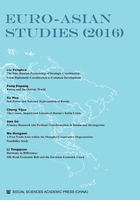
The Causes, Impact and Lessons of Russia's Ruble Crisis
Abstract: The strengthening of the dollar, the plummeting oil prices and Western sanctions comprise the main reasons for the large-scale devaluation of the ruble. But the fundamental reasons lie in the unsatisfactory economic performance within the country with stagnant economic development and lack of public confidence toward its prospect. The steep fall of the ruble has exerted serious negative impact on Russian society, but it also offers some lessons. In today's world where the integration of world economy is ever deepening, there is more turbulence in the financial market and the chance and frequency of large-scale crises is increasing. To maintain financial order and cope with emergencies, abundant foreign reserves are necessary. The interest rate lever serves as a double-edge sword and should be adopted prudently according to domestic and the market situations. A multiple of approaches to tackle financial hazards are more effective than a single measure. Technical means can be best utilized to adjust the market, and administrative intervention is not excluded. Sensitive reform measures should be avoided in key stages.economy. The crisis itself and the aftermath have generated a huge impact on the political and economic trajectory of Russian society. To be sure, the impact will continue in the foreseeable future and should not be underestimated.
Keywords: rate of ruble, foreign reserves, administration intervention, sensitive measures
The most eye-catching economic event in Russia in 2014 was the ruble crisis which erupted at the end of the year. The currency eventually tumbled tremendously, which dealt a severe blow to the already stagnant Russian
Since the beginning of 2014, the ruble, affected by various complicated factors from both within and outside the country, had seen a continuous decline. The pressure of imported inflation was mounting. In order to prevent the ruble from falling irrationally and ease the pressure from inflation, the Central Bank of Russia raised the interest rate in March, April, July and October respectively and also raised its deposit and repo rates. After raising interest rate for several times, the key rate went from 5.5 percent at the beginning of the year to 9.5 percent. However, the ruble kept falling without any signs of improvement. At the end of 2014, the situation worsened, with the fall intensifying and the declining scale sharpening. Under such circumstances, the Central Bank adopted the interest rate lever. On December 12, it hiked the key interest rate to 10.5 percent. However only three days later, the currency collapsed by tumbling more than 10 percent, the biggest fall since Russia's ruble crisis in 1998. This attracted world attention. The Central Bank took a big step by increasing the key rate to 17 percent. Such a move backfired though. On December 16, the ruble continued to be sluggish and fell sharply to a record-low level. Within a year, it fell 100 percent in an extreme case. On December 17 and 18, the Central Bank and the Finance Ministry jointly interfered by selling foreign currencies. The ruble began to stay smooth and rebounded by 10 percent on December 18 when the international oil prices rose. Russian officials then announced an end to the ruble crisis to maintain social stability. When people believed the crisis was really coming to an end, the Ministry of Economic Development on December 29 released a report on the social and economic development of the Russian Federation between January and November in 2014. The disappointing macroeconomic index in the first 11 months caused social panic again. The ruble saw a steep decline, even by 9.5 percent at some point. All efforts made by the Russian government came to nothing. Till now, the ruble is still unstable and possibilities of slow fall still remain.
